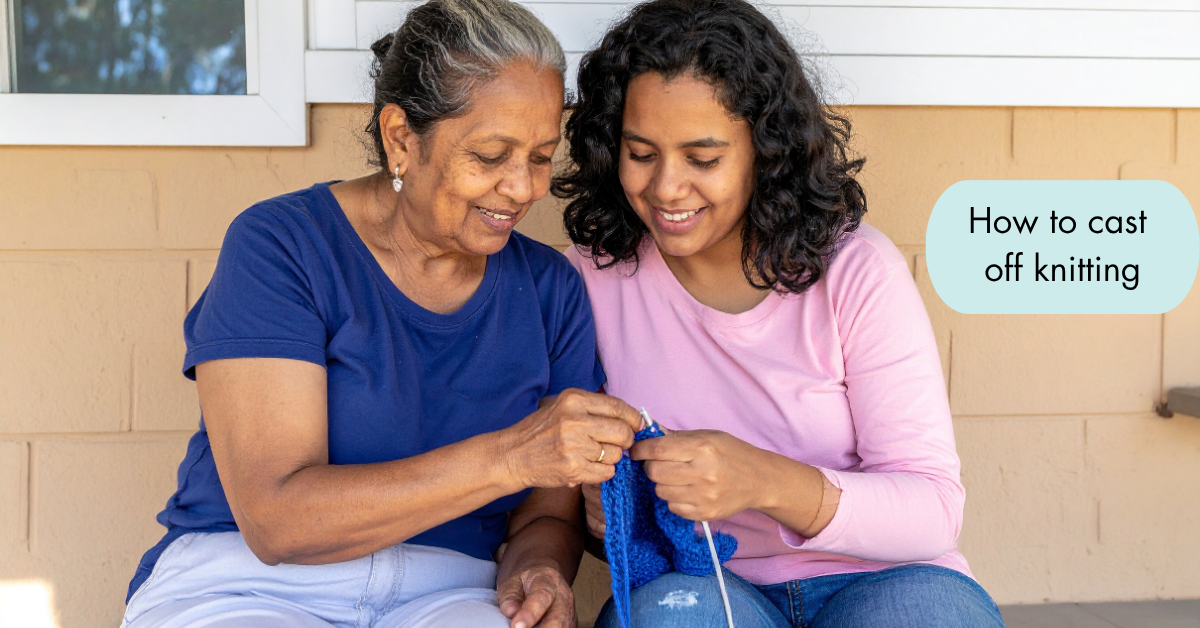Learning how to cast off knitting—also called binding off—is one of the most essential skills every knitter needs to complete a project. Whether you’re finishing a scarf, sweater, hat, or dishcloth, casting off secures your stitches and prevents your work from unraveling.
In this guide, we’ll explain step-by-step how to cast off knitting, including different methods and tips for getting the perfect edge every time.
What Does “Cast Off” Mean in Knitting?
Casting off means finishing your last row of knitting in a way that locks the stitches so they don’t come undone. Once you’ve bound off, your project is officially done—at least on the needles.
The most common way to cast off is the standard bind-off, which creates a neat, firm edge. But depending on your project, you may choose other types for extra stretch or style.
What You’ll Need
- Your knitting project
- A pair of knitting needles (same as used for the project)
- Scissors
- A yarn needle or tapestry needle (for weaving in ends)
How to Cast Off Knitting Step-by-Step
This method works for both knit and purl stitches and is ideal for beginners.
Step 1: Knit Two Stitches
Start by knitting the first two stitches on your left-hand needle, just like you would in a regular knit row.
Step 2: Lift First Stitch Over Second
Using your left needle, pick up the first stitch (the one further from the tip of the right needle) and lift it over the second stitch. Let it drop off the needle. You now have one stitch on the right needle.
Step 3: Knit One More
Knit another stitch from the left-hand needle so you once again have two stitches on the right needle.
Step 4: Repeat
Repeat the process: lift the first stitch over the second and drop it off. Continue until you have one stitch left on the right needle.
Step 5: Cut and Pull Through
Cut the working yarn, leaving about 6 inches. Use your needle to pull the yarn tail through the final loop to secure it. Tug gently to close the stitch.
Congratulations—you’ve just cast off your knitting!
Tips for a Perfect Bind-Off
- Keep it loose: If your edge feels too tight, use a needle one size larger for the cast-off row.
- Try a stretchy bind-off for socks, cuffs, or anything that needs flexibility.
- Match the style: Use a cast-off that complements your stitch pattern (e.g., knit-wise for garter, purl-wise for ribbing).
- Practice on a swatch before finishing a big project.
Alternative Cast-Off Techniques
1. Stretchy Bind-Off (Jeny’s Surprisingly Stretchy Bind-Off)
Ideal for ribbing or cuffs. It’s a bit more involved but adds needed flexibility.
How to do it: Before knitting each stitch, wrap the yarn around the needle backward (a yarn-over), then knit the stitch. Bind off as usual, lifting over both the stitch and the yarn-over.
2. Purl Bind-Off
Same as the standard, but you purl instead of knit. Useful for pieces finished on the purl side.
3. I-Cord Bind-Off
Creates a rounded, decorative edge. Great for shawls or garment necklines.
How to do it: Cast on 3 extra stitches, then work a series of slips and knits while binding off the original stitches behind them.
When to Cast Off
Cast off when:
- You’ve completed your pattern’s final row.
- Your piece is the desired length.
- You’re finishing a shape (like the bottom of a scarf or the neckline of a sweater).
Just make sure not to cast off too early—you can’t add more rows without undoing the bind-off.
What’s the Difference Between Casting Off and Binding Off?
Nothing—they’re the same thing! “Bind off” is commonly used in the U.S., while “cast off” is the preferred term in the U.K. and other English-speaking regions. You can use either term interchangeably.
Final Thoughts on How to Cast Off Knitting
Mastering how to cast off knitting is a vital step that turns your work-in-progress into a finished, functional item. Whether you’re making a beginner scarf or a complex cardigan, the cast-off is your final touch. Take your time, practice different techniques, and enjoy the satisfaction of completing your knitting projects with confidence.

